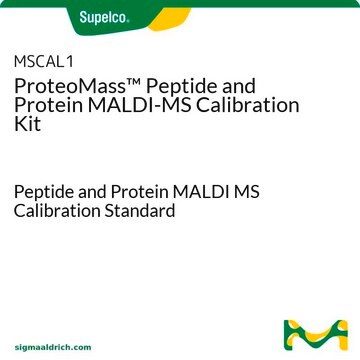MSCAL2
ProteoMass™ Peptide MALDI-MS Calibration Kit
Peptide MALDI MS Calibration Standard
Synonym(s):
Peptide Mass Spectrometry Calibrators
About This Item
Recommended Products
product line
ProteoMass™
quality
Peptide MALDI MS Calibration Standard
application(s)
cleaning products
cosmetics
flavors and fragrances
food and beverages
personal care
storage temp.
15-25°C
Application
ProteoMass™ Peptide MALDI-MS Calibration Kit has been used as a mass calibration standard for MALDI-TOF MS (matrix assisted laser desorption ionization-time of flight mass spectrometry) analysis.
Legal Information
Kit Components Also Available Separately
- B4181ProteoMass™ Bradykinin Fragment 1-7 MALDI-MS Standard, vial of 10 nmol, monoisotopic mol wt 756.3997 Da 2 x 10SDS
- A8846ProteoMass™ Angiotensin II MALDI-MS Standard, vial of 10 nmol 2 x 10SDS
- P2613ProteoMass™ P14R MALDI-MS Standard, vial of 10 nmol 2 x 10SDS
- A8346ProteoMass™ ACTH Fragment 18-39 MALDI-MS Standard, vial of 10 nmol, monoisotopic mol wt 2,464.1989 Da 2 x 10SDS
- I6154ProteoMass™ Insulin chain B oxidized MALDI-MS Standard, vial of 10 nmol 2 x 10SDS
- Acetonitrile 30 mL
- C8982α-Cyano-4-hydroxycinnamic acid, suitable for MALDI-TOF MS 8 x 10SDS
related product
Signal Word
Danger
Hazard Statements
Precautionary Statements
Hazard Classifications
Acute Tox. 4 Dermal - Acute Tox. 4 Inhalation - Acute Tox. 4 Oral - Eye Irrit. 2 - Flam. Liq. 2 - Skin Irrit. 2 - Skin Sens. 1
Storage Class Code
3 - Flammable liquids
Flash Point(F)
35.6 °F
Flash Point(C)
2 °C
Certificates of Analysis (COA)
Search for Certificates of Analysis (COA) by entering the products Lot/Batch Number. Lot and Batch Numbers can be found on a product’s label following the words ‘Lot’ or ‘Batch’.
Already Own This Product?
Find documentation for the products that you have recently purchased in the Document Library.
Our team of scientists has experience in all areas of research including Life Science, Material Science, Chemical Synthesis, Chromatography, Analytical and many others.
Contact Technical Service










